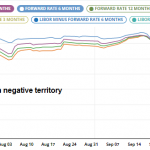The investment climate is being shaped by two powerful forces. First, is the very accommodative policy stance. This includes the United States, where despite delivering the fifth rate hike in the cycle, adjusted by headline CPI, remains negative. The balance sheet has begun being reduced, financial conditions in the US are easier now than a year ago.
The ECB’s bond purchase program, which has been cut in half to 30 billion euro a month starting now, is only the most visible part of its extraordinary monetary policy. Other elements include the minus 40 bp deposit rate, the full allotment of fixed rate refi operations, and the quality of the assets and collateral.
There are also roughly 750 billion euros of Targeted Long-Term Repos outstanding. Banks will begin to be able to pay back these borrowing early starting around mid-year. Given the absence of strong borrowing demand, and the negative rates at the ECB, it is not far-fetched to suspect that some banks will take advantage of the opportunity to return funds.
Even allowing for a conservative estimate that 10% is returned, it would offset 2.5 months of ECB buying in terms of the ECB’s balance sheet. It would be causing the ECB’s balance sheet to shrink at the same moment that officials will be considering what to do in September when the current program has a soft end date.
Around the same time, Greece may exit the multilateral assistance program. Some partial debt forgiveness will likely be debated again. This time Germany’s protagonist Schaeuble is the Speaker of Parliament rather than Finance Minister.
BOJ extraordinary policy remains intact.The shift to yield curve targeting, which meant capping the 10-year yield in a +/- 10 bp range around zero, alongside charging 10 bp for some deposits, ended up requiring fewer purchases of JGBs. It has a number of different lending facilities whose terms are also accommodative.
In addition to the accommodative monetary policy, fiscal policy is also supportive. The US just announced significant tax cuts even as the economy showed signs of accelerating. The first official read of Q4 GDP is due at the end of the month, and a three-handle would be the third consecutive such quarter, the longest streak since H2 2004 and Q1 2005. Even though it does not make it into the headlines often, the deregulation efforts by the federal government are significant. On top of this, an infrastructure initiative is expected to be unveiled shortly.














Leave A Comment